Ocean side
15th to 22nd June 2023
For the third day in a row, we had a little challenge at our first lock of the day. This time we sallied forth from our mooring at Montchanin at the top of the Canal de Centre, looking forward to our first lock ‘aval’ (down). Generally speaking going down is quite a lot easier.

Into the lock and a gentle glide to the bottom as expected, but then, as Stu did his normal expert flick of the rope to take it off the bollard, it got stuck!

So crew went up the ladder to help (the ladder being my end of the lock) and was able to quickly undo it.
The gates opened and we were off.
It’s these little tiny challenges that keep us on our toes! Never get smug and never get bored.

As always there was plenty to see along the way.
Early on this little old bridge over part of the Bourbince river caught my eye. This was apparently a false arm (Faux Bras) of the Bourbince but I could not find where the main river flowed nearby.



It was obvioul;sy a busy time on the local farmers with tractors alongside us and over us all the way along the canal that day. We enjoy seeing the seasonal aspects of life in the countryside, whilst knowing that it is hard work and long days in mid summer.
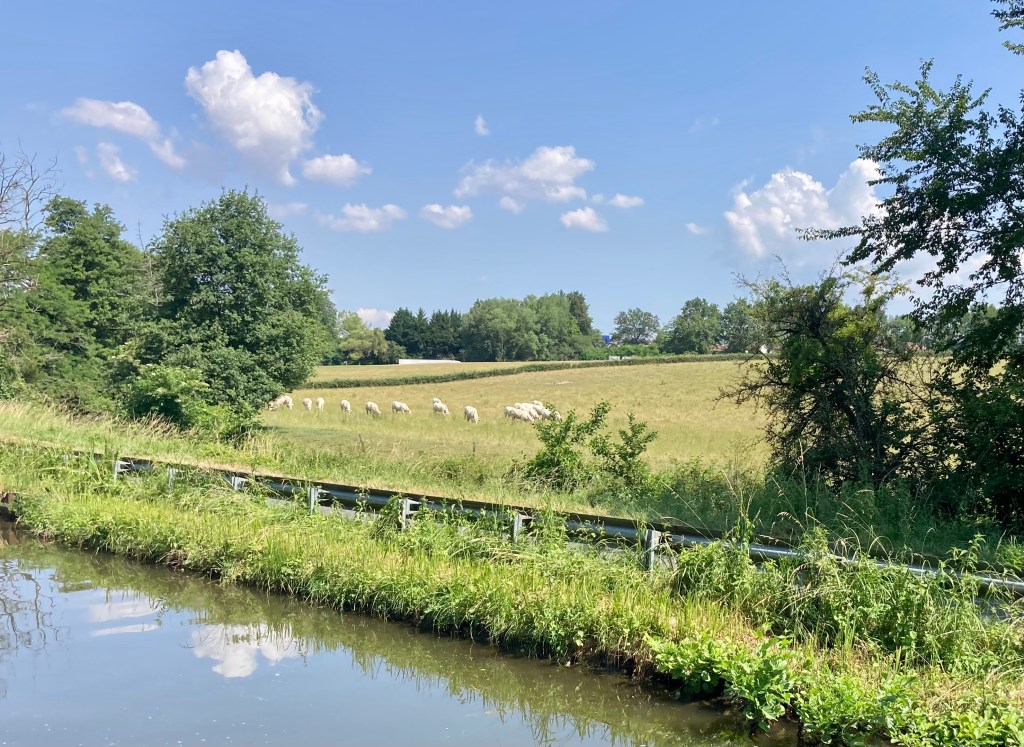
It all results in mile after mile of beautiful countryside.



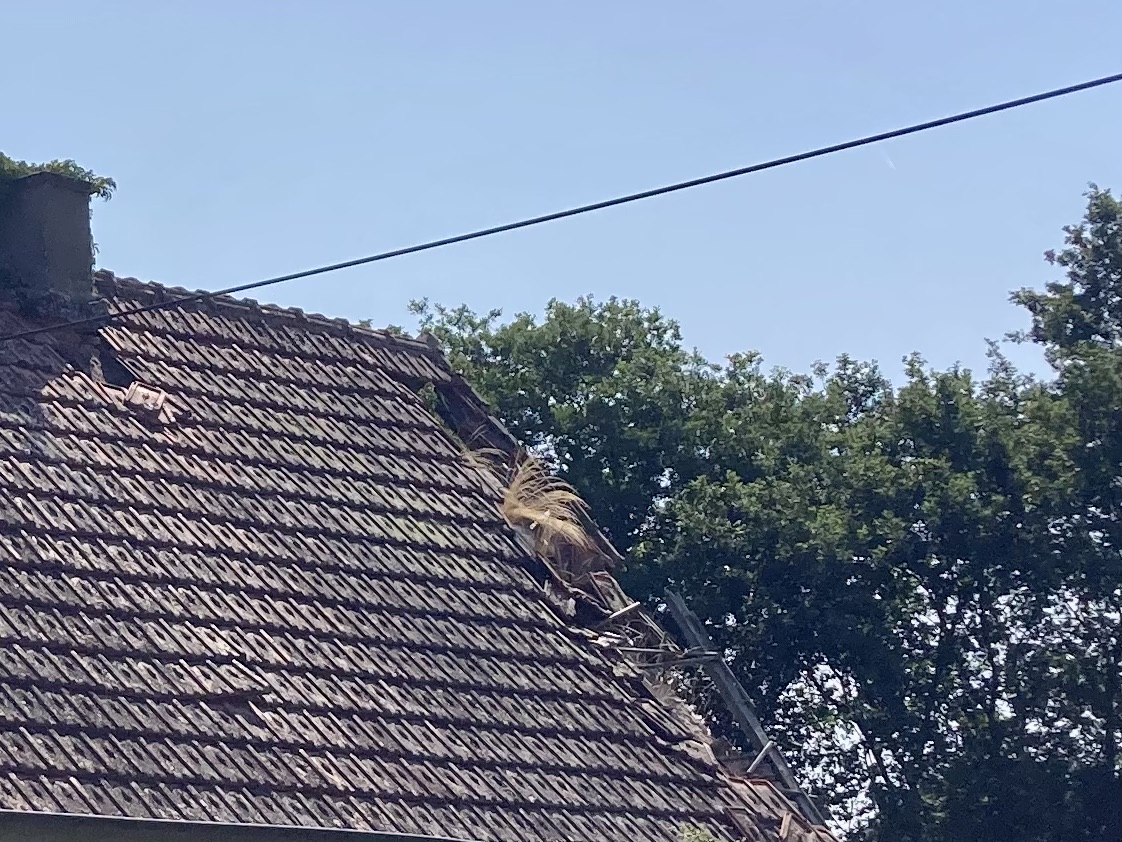

I’m a bit of a nerd about locks – the houses that the lock keepers used to live in, the mechanics of the lock operation, odd signs that appear nearby. Here we have some lovely shadows that appeared on the doors of two locks as we started downhill; a lock house with roof caved in that once was someone’s proud home (I like to imagine a young lock keeper bringing his new bride back to his tied lock house where they could live together, grow fruit and veg, raise a family etc); a sign that could only be in France, pointing you to Escargots (snails!).

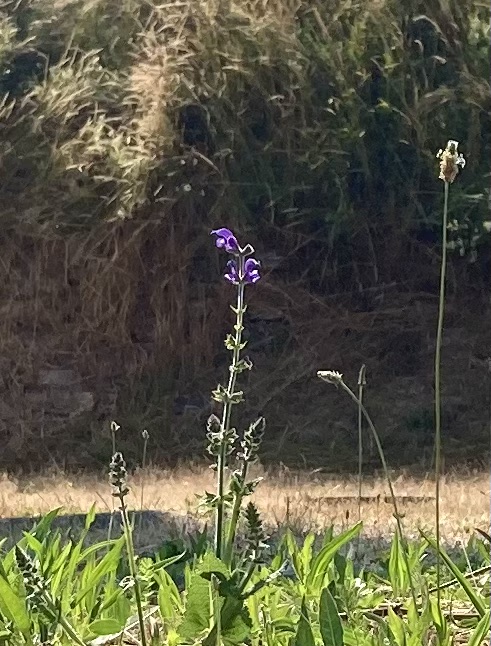

I also manageds to snap the occasional bit of wildlife – a grasshopper that flew in an open hatch, a purple lockside flower, and, maybe, an osprey.

As we got closer to Montceau-les-Mines, our mooring for a few days, we began to see examples of the industrial archeaology left behind after centuries of mining and ceramics.
To be honest we are not sure what this is, though it’s probably an ornate lime kiln, and it’s near Blanzy
Blanzy has planted banks of lilies along the canal close to the pleasant mooring that we stopped at in 2016, but this year we continued on a kilometre or two.
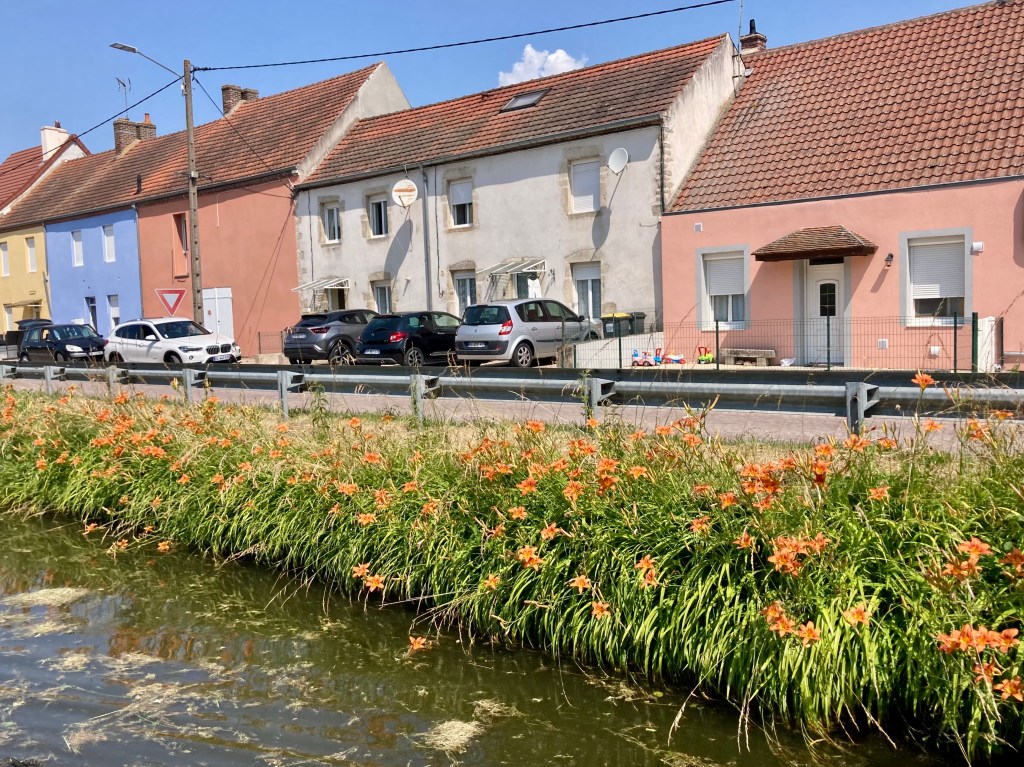

We are very good at arriving at our last lock of the day at 1205, when the locks close from 1200 until 1300.
In this case it was the lock at Montceau and we tied up to some nice blue railings, had lunch and waited to cover the last few hundred yards of our journey.

We had booked into the port at Montceau-les-Mines – very good value for our almost 20m barge at €40 for three nights including water and electricity. The port is in the centre of this attractive busy little town and the pontoons are new, all laid out behind a secure gate.
We woke up on Saturday to find a big food market in full swing all along the edge of the port!
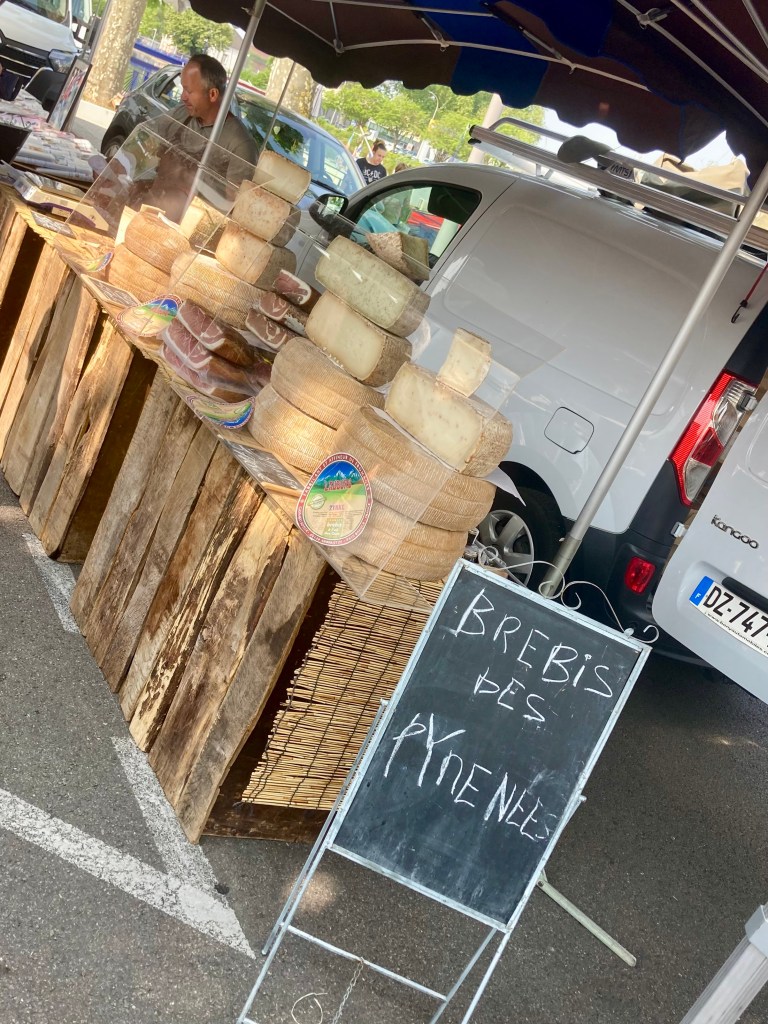
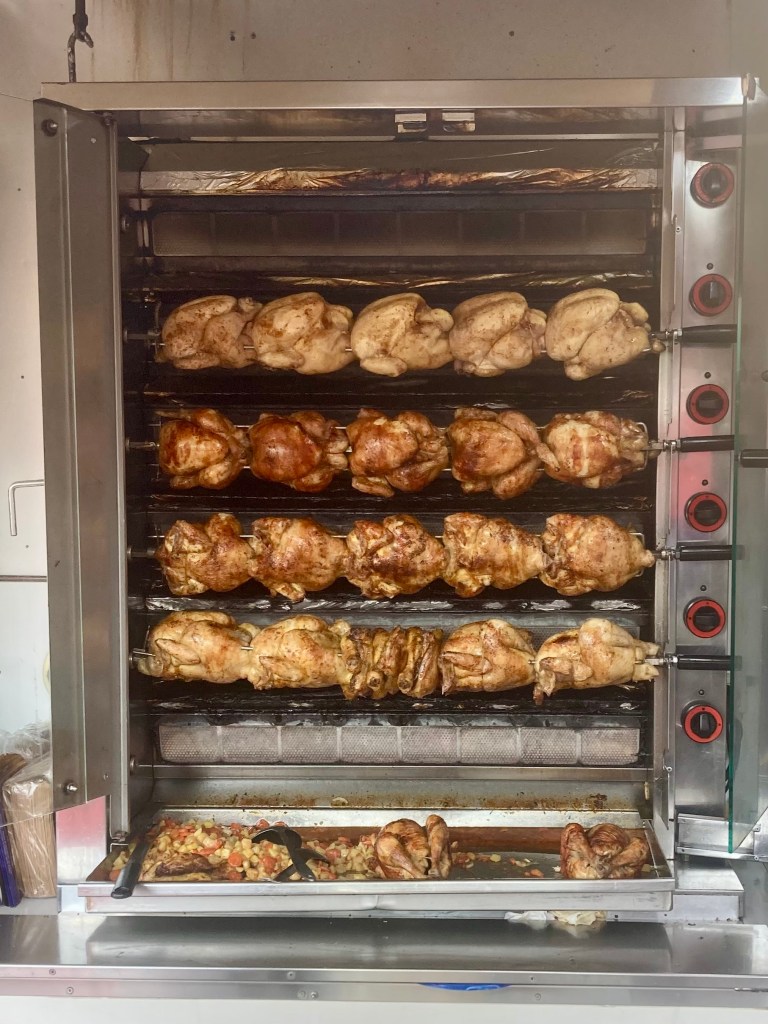

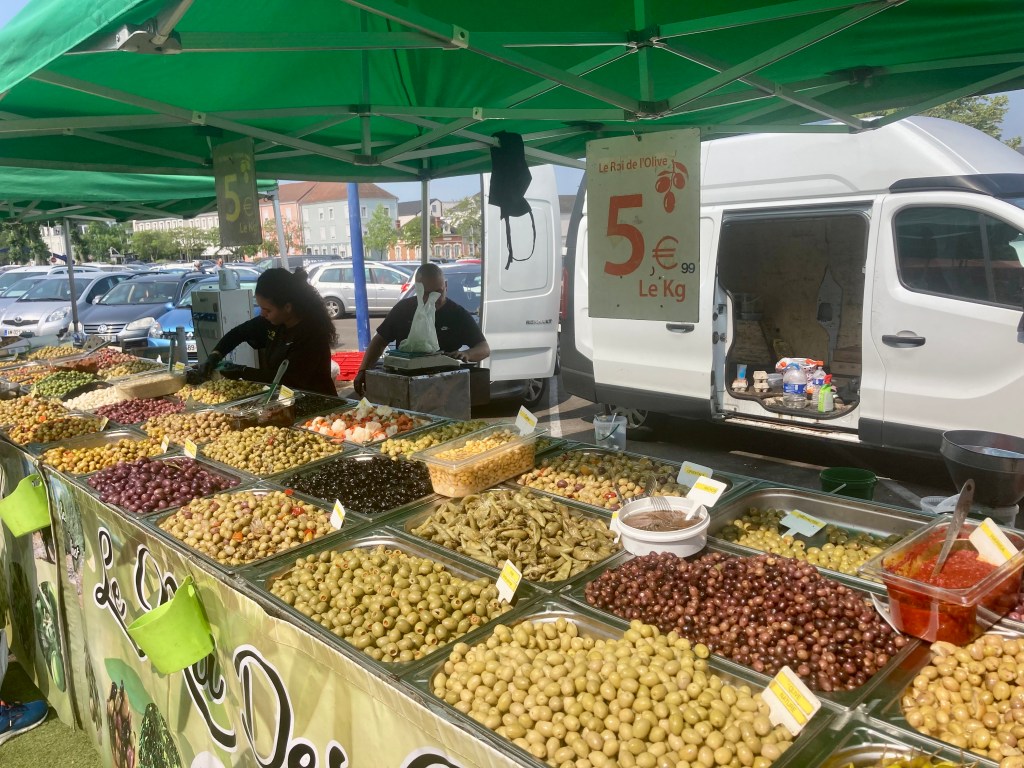



What a treat; I soon managed to fill two big bags with necessary fruit and veg, plus several treats; boeuf-en-gelée, not easily found and a memory from our family camping holiday when I was 16; butcher made pork rillettes; Brebis (sheep’s milk cheese), a delicious salad made from shredded Charolais beef, potato, tomato and cornichons; potato galettes, and some of the best gooiest soft cheese!

Well at least I didn’t come back with several live chickens.

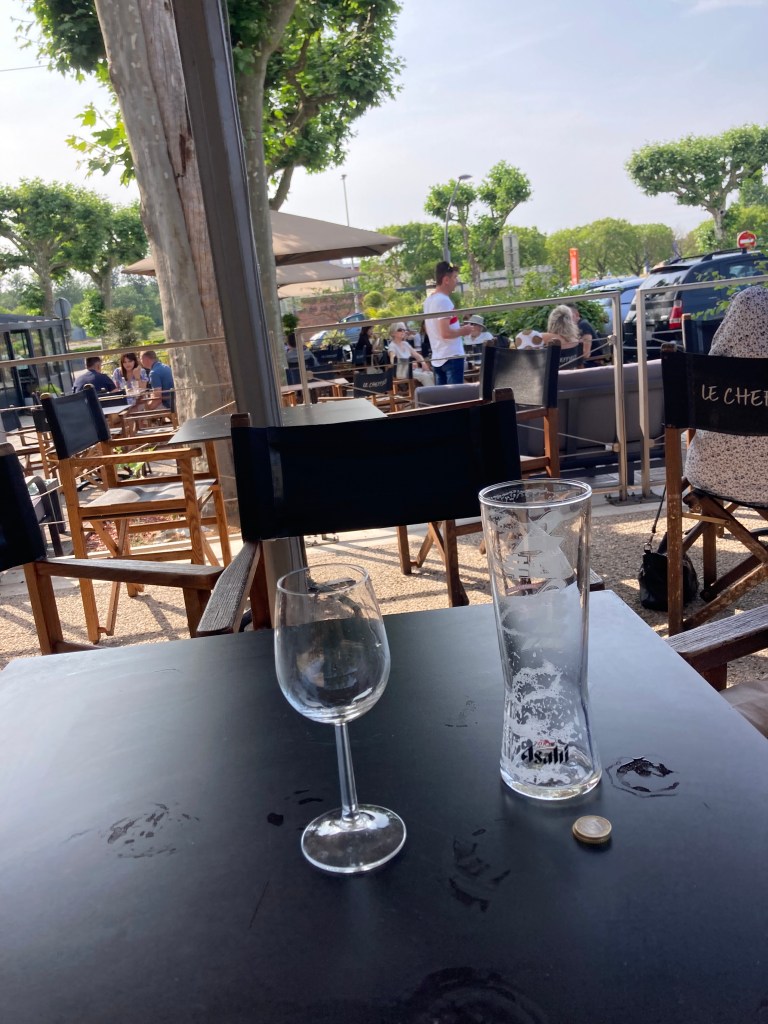
Friday and Saturday early evenings saw us at a local bar in the shade enjoying a cooling beer – the temperatures were around 28-30C each day, with nice breezes from time to time.
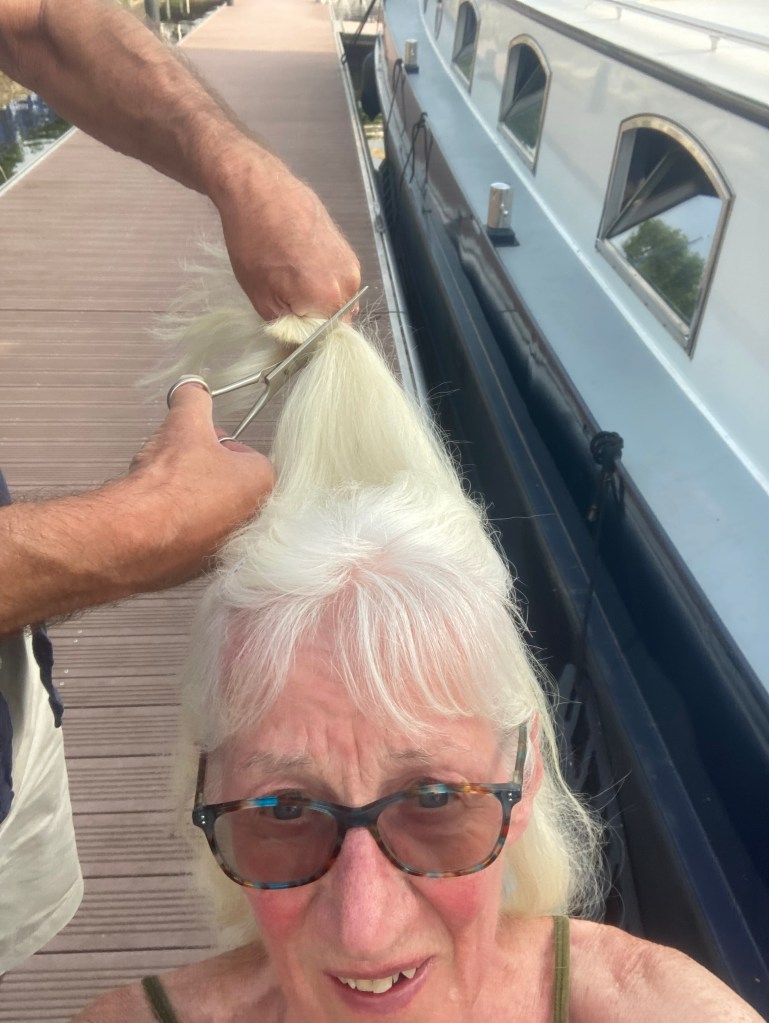


The beer and wine and heat combined might have had something to do with a sudden decision to turn the Captain into a hairdresser and cut off my longish hair.
It was a bit of a thing because I had been growing it for 9 years ever since I stopped work. In my mind I was now a Granny, and Grannies have long white hair. Also I was on a boat and sailors have long pigtails.

But now I am over those thoughts. Coolness and practicality win.
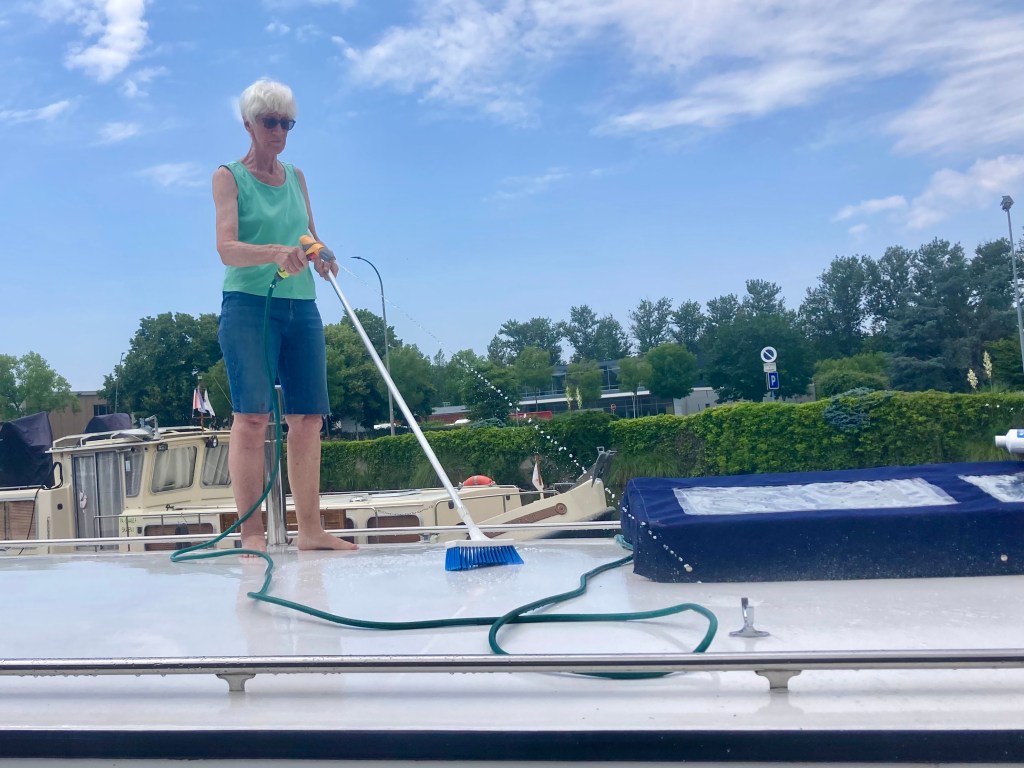
Sunday was a dedicated boat cleaning day. I had not had the wherewithal to get up on Stewart’s beautifully repainted white cabin roof since breaking my ankle, but felt ready for the challenge. It was worth it.
And later that night the skies gave the roof a final rinse with a thunderous downpour – a truly spectacular storm.
MONDAY
Leaving Montceau meant going under the three post levées (lift bridges) of the town. We called ahead and right on cue the first, bridge rose, followed by the second and third as we made our way along the canal. The time lapse video shows what it is like – three blue bridges, all lifting in different ways; good modern engineering.
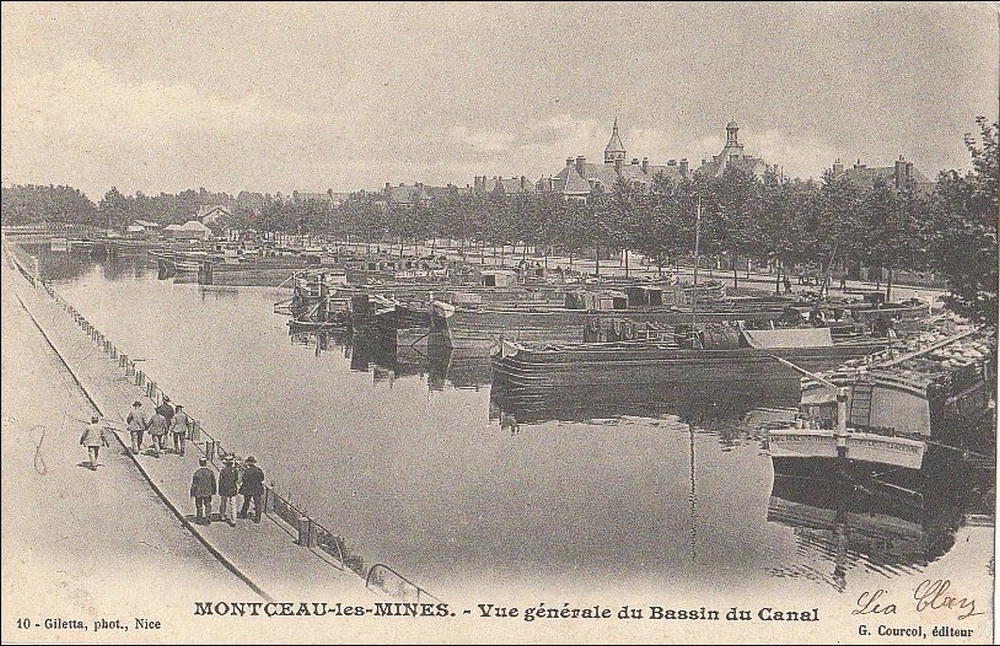
The town was famous, as its name suggests, for the coal industry. This canal was packed with barges moving coal and other cargo to other parts of France not much more than a century ago.
But we were quickly out into the country and although a small road ran alongside the canal the overwhelming sensation was of being out amongst the green.



At one lock a young heron (or was it a stork?) perched alongside for some minutes, and took off as we left. We thought heron, then stork, then heron! I researched online and to be honest I need a more able bird watcher to tell me what it was, please! There are a lot of both around the area, so hard to tell. (It was a stork….)



At another lock the flowers were what caught my eye. And along one bief (stretch) of the canal the wild sweetpeas were so riotous that their scent filled the air.

And then, at Ciry-le-Noble, this beautiful old building, once Claudius Martin’s pride and joy, graced the edge of the water.
Another piece of art nouveau architecture to enjoy.
We were aiming for a town called Génelard, a nice place to stop. But three locks and six kilometres out we saw a lovely shady place to stop for lunch. It was almost time for the locks to take their one hour lunch break and this mooring seemed very opportune.

A lovely serendipitous lunch mooring – so good we decided to stay the night!
The real attraction of this mooring was its tranquility. And we were not the only ones to appreciate it.
An intriguing ‘installation’ next to Calliope also served as a bench for an elderly couple and their picnic.
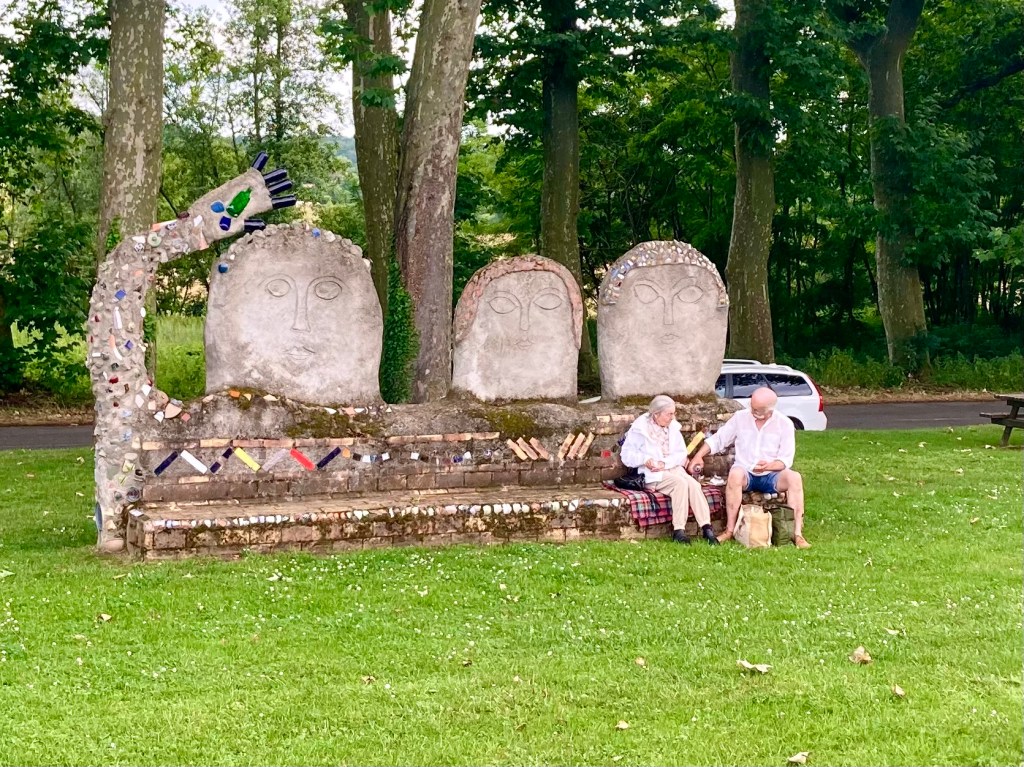

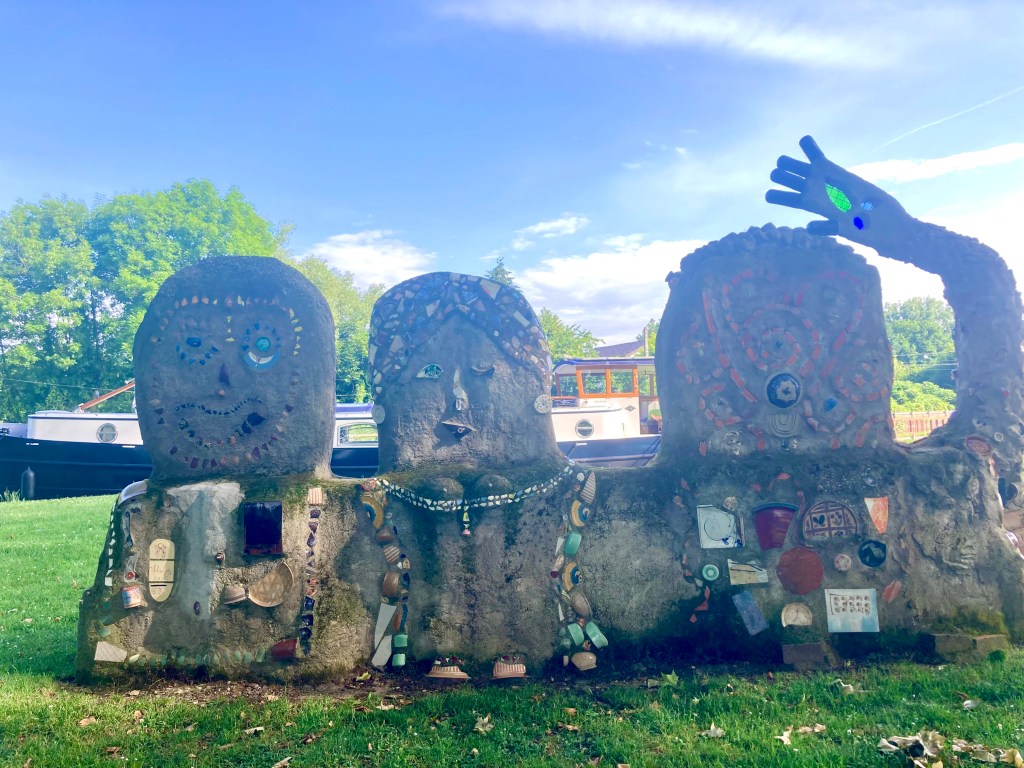
On Tuesday we made it the final 6 kms to Génelard – not an onerous journey. The intriguing bench cum statue by Ciry écluse waved us farewell.
We went through more lovely countryside, listening to nightingales, reed warblers and frogs as we went.

I have mentioned how broken down some of the old lock houses can be; today we found one that had been smartened up and turned into a gite. It looks a lovely place to stay – lock 15 Ocean.




The final beef into Génelard is through a cutting, decorated with reminders of the industry of the area – metal letters and images.

On this day it was the last lock of the day that caught us out. We came into Génelard lock, looking down at the basin where we could see plenty of mooring places; smiles all round. Stu pulled the well known blue rope and the gates closed behind us.

That was that. We sat there waiting for the lock to empty. We waited for quite some time, and eventually decided there was a problem. Luckily it was not the ‘heures pour le déjeuner des éclusiers”, so a phone call brought us assistance within a few minutes. And while we waited I could investigates the sign on one of the lockside cottages that told me that the artist Jean Laronze lived there for a good part of his life.

As soon as we were tied up I walked up (and it is UP) into the town and found a boulangerie that not only had good bread, but also my favourite ‘flan’ – a sort of French custard tart.

Génelard was a key centre of industry, including a big company called Fournier et Moulillon who made mining equipment that was sold across the world. In the early C20th they ‘hid’ their industrial buildings behind a huge art deco facade.
Génelard is also known for being on the demarcation line between occupied and free France during WW2; a small museum remembers what it was like. to live through those times
Our next stop was Paray-le-Mondial. I had been looking forward to this as when we visited 7 years ago we discovered that it is a town steeped in religious history and with some lovely buildings and waterways.

We started off past another VNF depot, complete woith working barge moored outside.


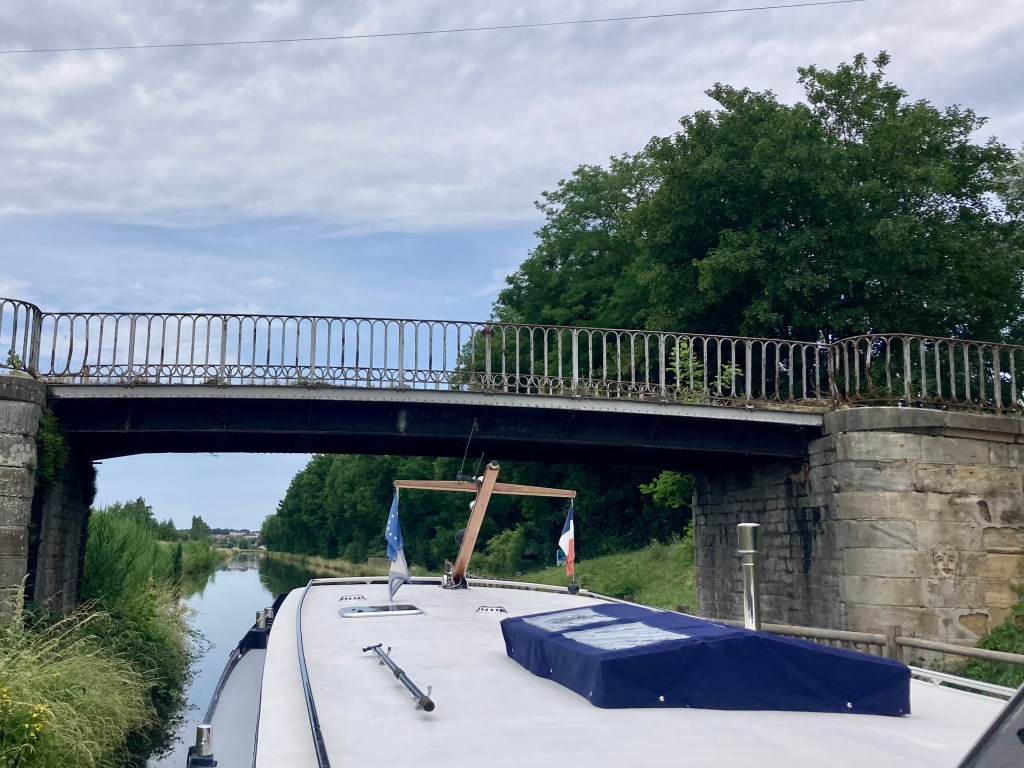
Along the way we passed so many things that caught my eye; a kiln for firing pottery, the Chateau of Digoine, the ancient ironwork of bridges.


There were more ex-lock keeper’s houses, mostly in a state of complete disrepair, but occasionally one had been bought and restoreed to glory.


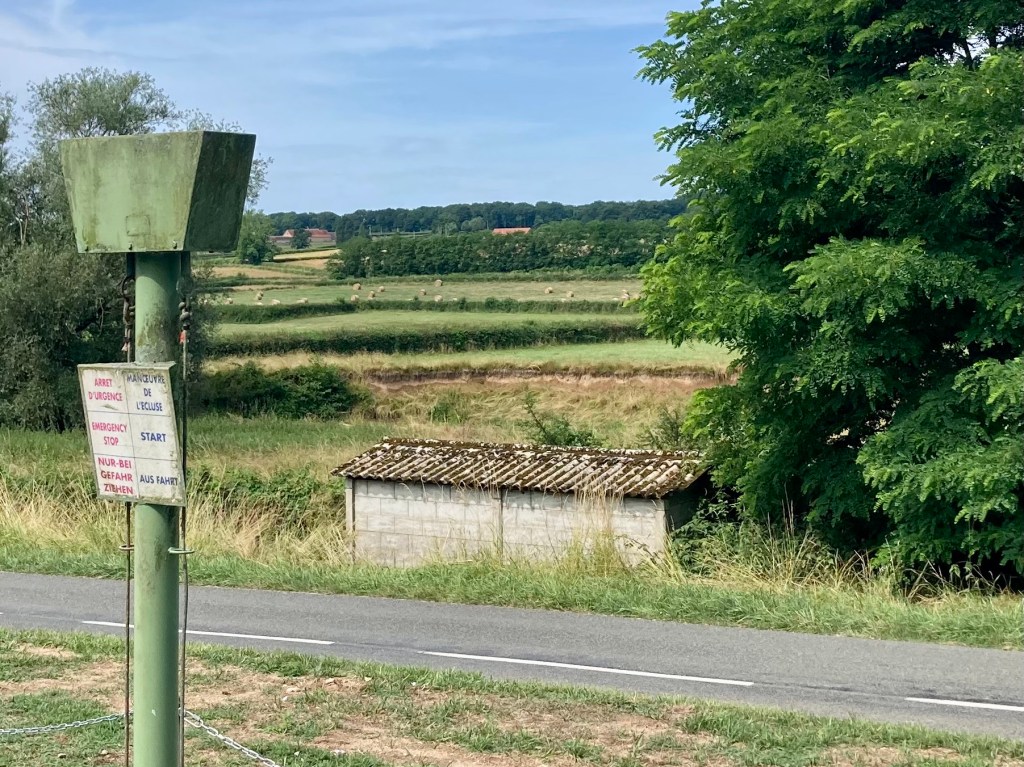
And on the more natural side, sleepy cattle, black kites soaring, and views across the French landscape.
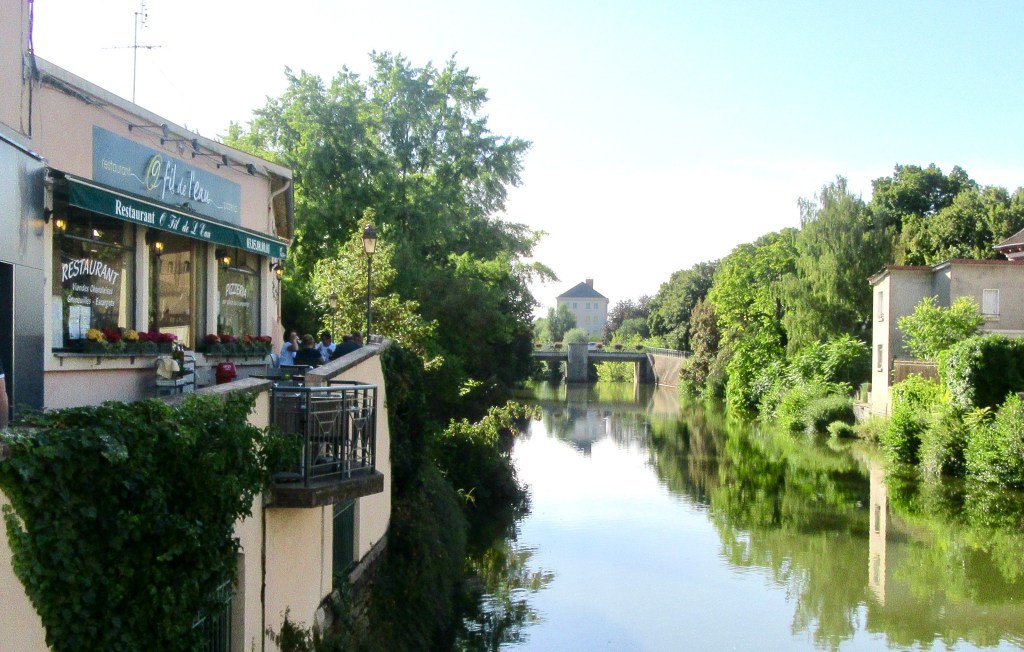

Our last visit to Party 7 years ago coincided with the last night of our teenage granddaughter’s visit with her mate Abi and the most memorable event of that evening was going for a pizza in a restaurant overlooking the river that flows through the town.
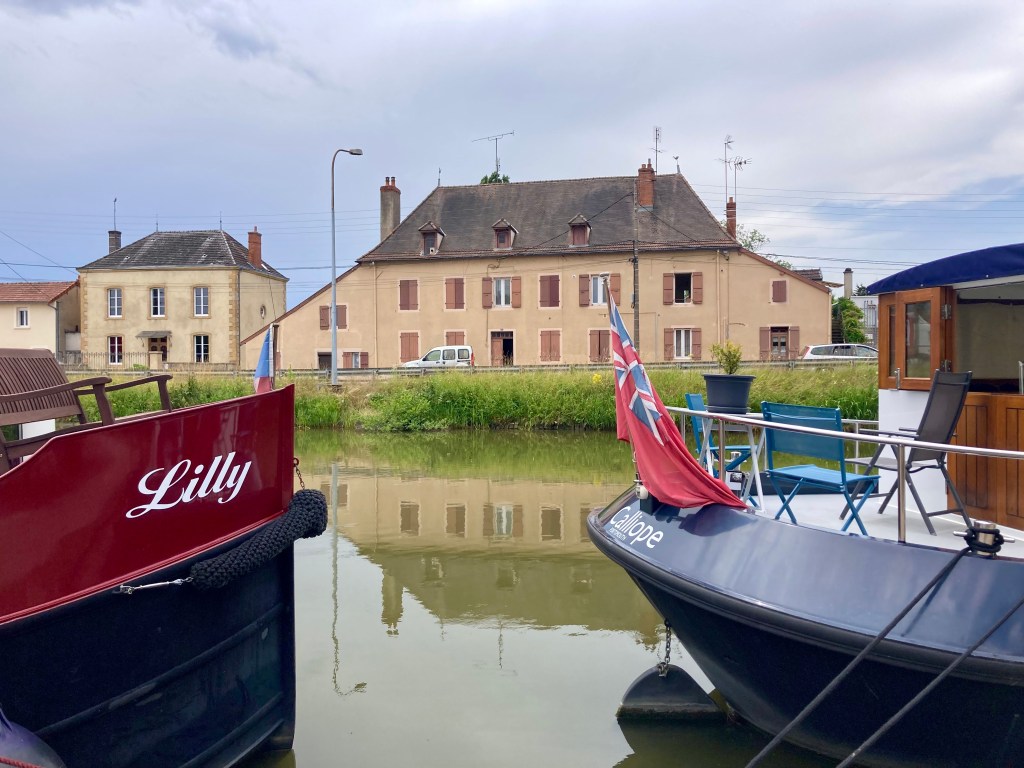
This time we thought we would moor up in the marina basin, meeting up with fellow Piper boat Lilly. The mooring gave really good access to the town and we had a bit of a promenade round, but it was also a bit noisy and dusty for us ‘ruralites’ so we stayed just one night.
Even so we went for a good walk round to remind ourselves of the rather wonderful surroundings. Being here in August is to find oneself immersed amongst thousands of pilgrims who come from all over the world and sing and chant happy Christian things late into the night.
June is a lot quieter…..







The weather was not looking good for the next day, Wednesday. Nonetheless after a quick boulangerie visit we set off, only to encounter an absolute downpour within five minutes.

Luckily we could tie up and wait for it to pass, rather than enjoy a total drenching at the next lock.
Soon we were moving on again and had a pleasant morning of increasingly rural views and better weather ….
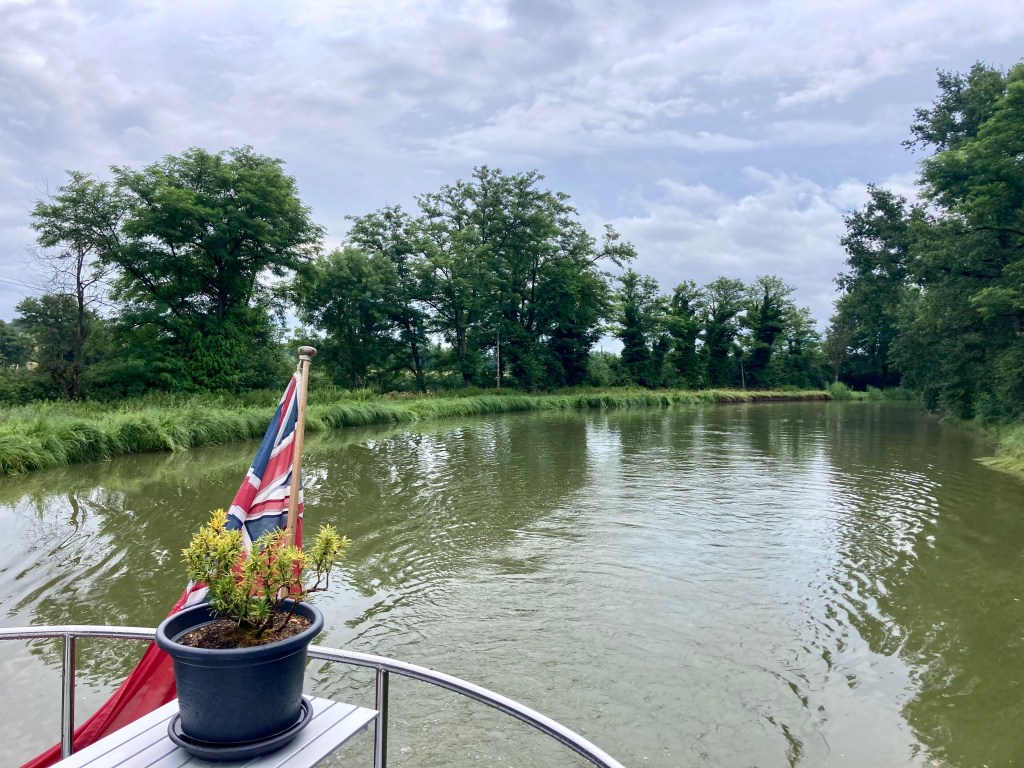

… until we reached the outskirts of Digoin where we passed by the redundant entrance to the old 14km long Arroux canal which brought iron ore from Montluçon.
The canal is only 3m wide, allowing the old 2.6m Berrichon barges to move along, with 20 widening to allow barges to pass each other.
.


If you will indulge me, just a little more history. The Berrichon barges were often pulled by donkeys or mules, but recently by the owners of the boat. It is a little easier than it might seem as since the initial inertia is overcome the barge will move with little effort. We quite frequently move the 38 ton Calliope along a quay using just people power.

We were lucky once again to find a good long space in the ‘port’, and once more next to another Piper boat, whose crew emerged to help us moor up. Thank you Pascal and Eveline on Pas’ine.
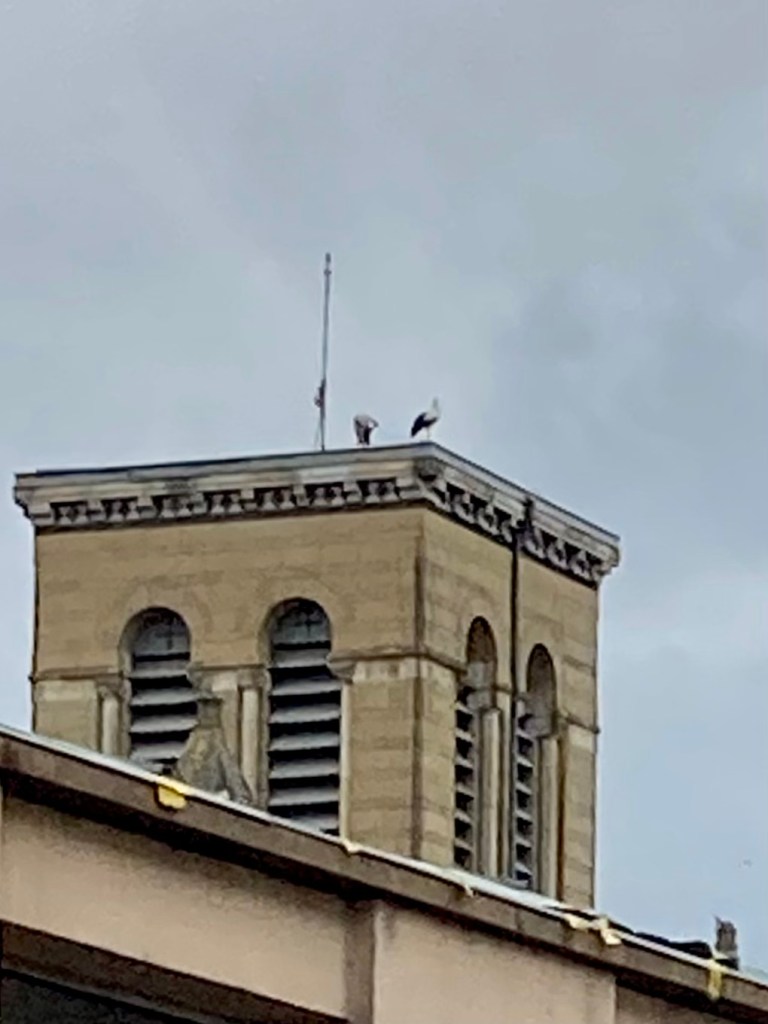


Digoin, a fairly average town, provided some excitement for us with a stork’s nest on top of the church and a wonderful Art Nouveau post office. Yes, definitely storks this time.
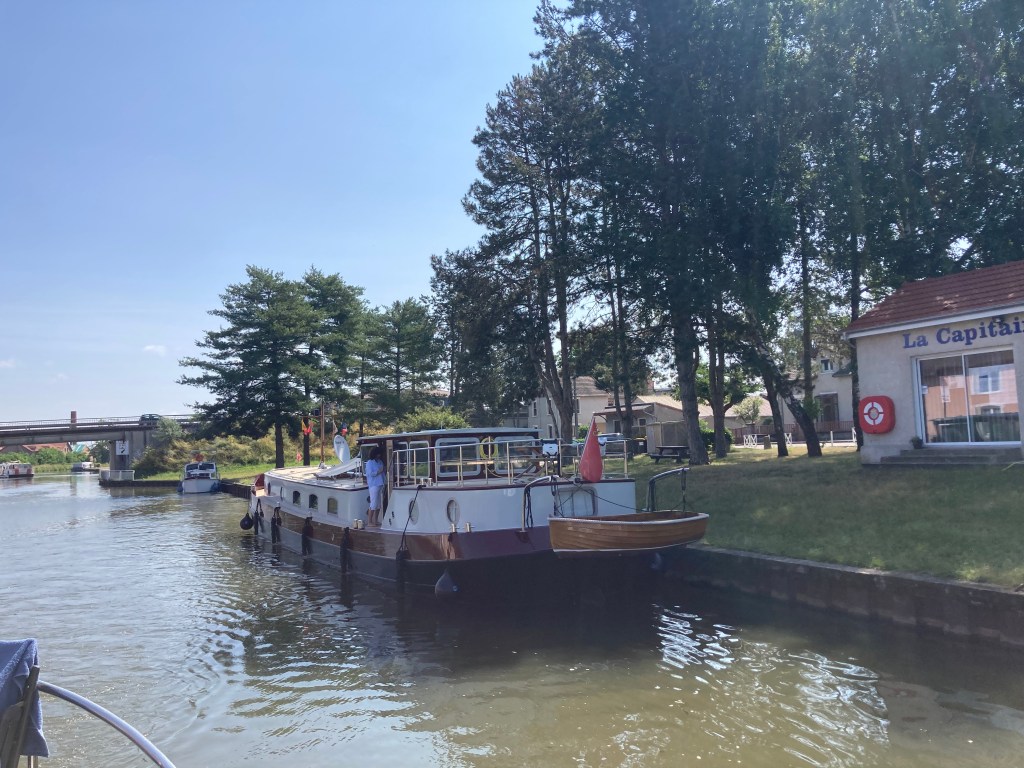
Nonetheless we only stayed the one night, availing ourselves of the Friday market before we left and setting off for the last 100m before the Canal du Centre becomes the Canal Lateral à La Loire, and a new journey begins with an unexpected wait to cross the 240m long Digoin aqueduct.
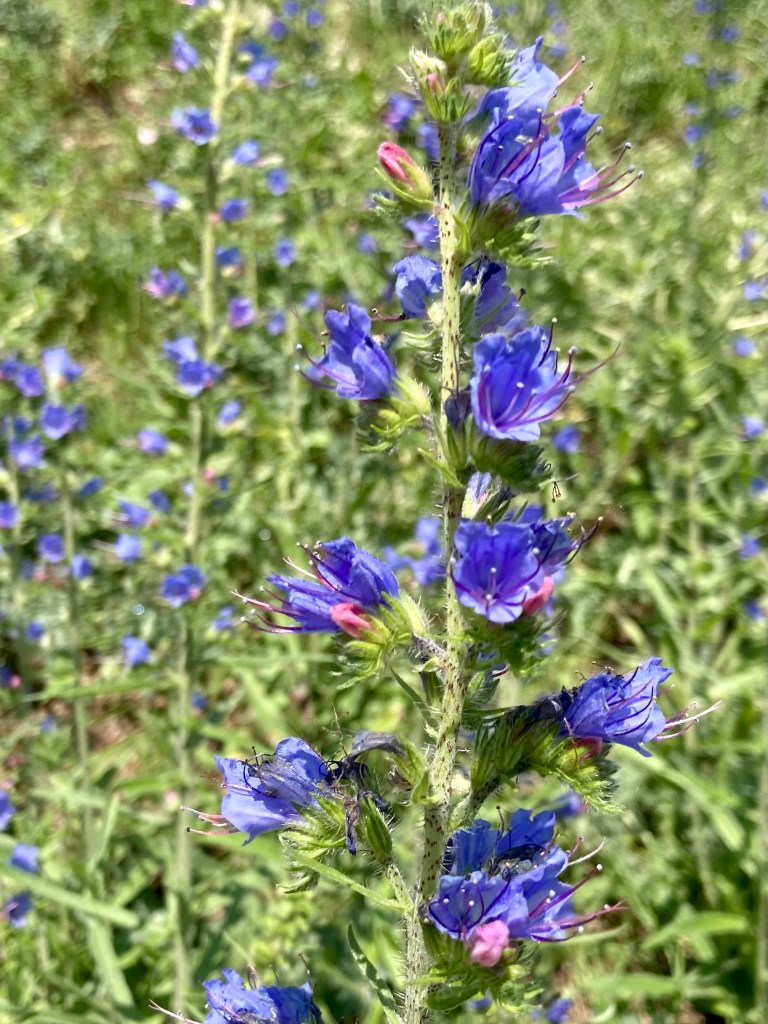
But that is another chapter!



